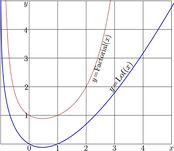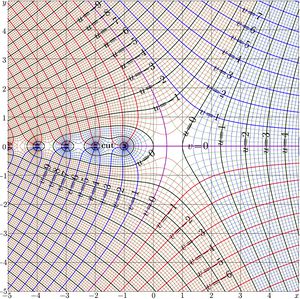Difference between revisions of "Lof"
m (Text replacement - "\$([^\$]+)\$" to "\\(\1\\)") |
|||
| Line 1: | Line 1: | ||
| − | [[File:Lofplot.jpg|174px|thumb| |
+ | [[File:Lofplot.jpg|174px|thumb|\(y\!=\)[[Factorial]]\((x)\) and \(y\!=\)[[Lof]]\((x)\)]] |
| − | [[File:Lofmap.jpg|300px|thumb| |
+ | [[File:Lofmap.jpg|300px|thumb|\(u\!+\!\mathrm i v=\mathrm{Lof}(x\!+\!\mathrm i y)\)]] |
| − | [[Lof]] (or [[lof]]) is analytic extension of function |
+ | [[Lof]] (or [[lof]]) is analytic extension of function \(~z\! \mapsto\! \ln\!\big(\)[[Factorial]]\((z)\big)~\) , that is holomorphic in the most of the complex \(z\) plane (except \(z\!\le\!-1\)). |
| − | [[Complex map]] of function [[lof]] is shown in figure at right with lines |
+ | [[Complex map]] of function [[lof]] is shown in figure at right with lines \(u\!+\!\mathrm i v=\mathrm{Lof}(x\!+\!\mathrm i y)\) in the \(x\),\(y\) plane. |
==Terminology and apology== |
==Terminology and apology== |
||
| Line 17: | Line 17: | ||
Properties of function [[Lof]] follow from those of [[Factorial]]. |
Properties of function [[Lof]] follow from those of [[Factorial]]. |
||
| − | While the real part of the argument |
+ | While the real part of the argument \(z\) dominates, |
| − | + | \(\mathrm{Lof}(z) = \) \(\displaystyle |
|
\ln\!\left( \int_0^\infty t^z \exp(-t)\, \mathrm{d}t |
\ln\!\left( \int_0^\infty t^z \exp(-t)\, \mathrm{d}t |
||
| − | \right) |
+ | \right)\) |
For other values of the argument, |
For other values of the argument, |
||
| − | appropriate integer factor of |
+ | appropriate integer factor of \(2\pi\mathrm i\) should be added to the right hand side of the integral representation in order to get the correct branch of [[Lof]]. |
The correct branch can be achieved with formula of translation |
The correct branch can be achieved with formula of translation |
||
| − | + | \(\mathrm{Lof}(x\!+\!1)=\mathrm{Lof}(x)+\ln(x)\) |
|
Behaviour of [[Factorial]] at large positive part of the argument (Stirling formula) |
Behaviour of [[Factorial]] at large positive part of the argument (Stirling formula) |
||
Determines the asymptotic expansion |
Determines the asymptotic expansion |
||
| − | + | \(\displaystyle |
|
| − | \mathrm{Lof}(x) \approx |
+ | \mathrm{Lof}(x) \approx \) \(\displaystyle |
| − | \big(\ln(x)-1\big) x |
+ | \big(\ln(x)-1\big) x\) \(\displaystyle |
| − | +\frac{\ln(2\pi x)}{2} |
+ | +\frac{\ln(2\pi x)}{2}\) \(\displaystyle |
| − | +\frac{1}{12 x} |
+ | +\frac{1}{12 x}\) \(\displaystyle |
| − | -\frac{1}{360 x^3} |
+ | -\frac{1}{360 x^3}\) \(\displaystyle |
| − | +\frac{1}{1260 x^5} |
+ | +\frac{1}{1260 x^5}\) \(\displaystyle |
| − | -\frac{1}{1680 x^7} |
+ | -\frac{1}{1680 x^7}\) \(\displaystyle |
| − | +O\!\left(\frac{1}{x^{9}}\right) |
+ | +O\!\left(\frac{1}{x^{9}}\right)\) |
==Applications== |
==Applications== |
||
Latest revision as of 18:43, 30 July 2019
Lof (or lof) is analytic extension of function \(~z\! \mapsto\! \ln\!\big(\)Factorial\((z)\big)~\) , that is holomorphic in the most of the complex \(z\) plane (except \(z\!\le\!-1\)).
Complex map of function lof is shown in figure at right with lines \(u\!+\!\mathrm i v=\mathrm{Lof}(x\!+\!\mathrm i y)\) in the \(x\),\(y\) plane.
Terminology and apology
Name Lof is created from the beginning of names Logarithm and Factorial. In vicinity of positive part of the real axis, (for moderate imaginary part of the argument, it is, indeed, just combination of these two functions.
Properties of function Lof
Properties of function Lof follow from those of Factorial.
While the real part of the argument \(z\) dominates,
\(\mathrm{Lof}(z) = \) \(\displaystyle \ln\!\left( \int_0^\infty t^z \exp(-t)\, \mathrm{d}t \right)\)
For other values of the argument, appropriate integer factor of \(2\pi\mathrm i\) should be added to the right hand side of the integral representation in order to get the correct branch of Lof.
The correct branch can be achieved with formula of translation
\(\mathrm{Lof}(x\!+\!1)=\mathrm{Lof}(x)+\ln(x)\)
Behaviour of Factorial at large positive part of the argument (Stirling formula) Determines the asymptotic expansion
\(\displaystyle \mathrm{Lof}(x) \approx \) \(\displaystyle \big(\ln(x)-1\big) x\) \(\displaystyle +\frac{\ln(2\pi x)}{2}\) \(\displaystyle +\frac{1}{12 x}\) \(\displaystyle -\frac{1}{360 x^3}\) \(\displaystyle +\frac{1}{1260 x^5}\) \(\displaystyle -\frac{1}{1680 x^7}\) \(\displaystyle +O\!\left(\frac{1}{x^{9}}\right)\)
Applications
Lof happened to be useful for the analysis and debugging of implementations of various functions.
Factorial and its iterates (including non-integer and even not real iterates) are implemented using function lof. [1]
Lof happened to be useful for the analysis of the asymptotic behaviour of the Hermite Gauss modes, oscillator functions, and in particular, the Amplitude of oscillator function.
References
- ↑
http://www.springerlink.com/content/qt31671237421111/fulltext.pdf?page=1
D.Kouznetsov, H.Trappmann. Superfunctions and square root of factorial. Moscow University Physics Bulletin, 2010, v.65, No.1, p.6-12. (Russian version: p.8-14)
http://mizugadro.mydns.jp/PAPERS/2010superfae.pdf English version
http://mizugadro.mydns.jp/PAPERS/2010superfar.pdf Russian version
Keywords
Factorial, Hermite Gauss mode, Hermite number, Oscillator function,,

